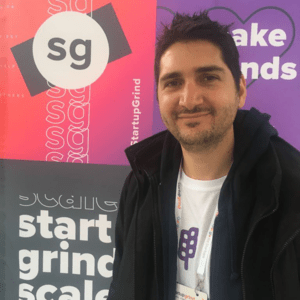I’m a computer engineer transformed into a ⚙️ passionate No Coder ⚙️. Reach out if you want to get introduced or learn more about the No Code world!
It’s not so complicated: How to craft content for cold outreach with Sardar Azimov
When it comes to cold email campaigns people don't have a clear idea of how their email content should look like or how many steps it should have.
Does this sound familiar?
Tune into this engaging podcast episode featuring Sardar Azimov, founder of Skief Labs, as he shares his expertise in crafting high-converting cold email content.
Learn from Sardar's experience and pick up valuable tips to improve your cold outreach strategies and boost your startup growth.
Listen to this episode to learn more about:
- Sequence structures, number of steps, and follow-ups
- The value of understanding your audience’s challenges
- Segmentation, personalization, and what really matters
- The importance of copywriting and content-market fit
- How to scale such a process through a practical example
And all these in less than 26 min.
Transcript
Spyros Tsoukalas: Hello everyone. I’m excited to host today, Sardar Azimov, who is the founder of Skief Labs a growth and outbound agency, and an email marketing expert himself. So following two very nice blog posts on the GrowthMentor blog, I’m excited to discuss with him how to craft content for cold outbreaks. Welcome, Sardar!
Sardar Azimov: Hi Spyros. Nice to have you finally do this podcast session. I’m also excited to have this conversation with you. As you mentioned, we previously had two lengthy blog posts on cold outreach, mostly focused on the data and the tech side. And I guess this is the final piece that is missing from our puzzle, how to craft engaging content that converts for cold outbound campaigns.
Spyros Tsoukalas: Yes, perfect. So let’s get started. So would you like to share with us more from your experiences dealing with the structure of email sequences?
Sardar Azimov: What I have noticed, in each email campaign, people tend to either underestimate or overestimate the value of the content. One of the things that I have noticed is also the structure. Sometimes people don’t have a clear idea of how it should look like, or how many steps it should have. So ideally, when we craft an email sequence, we try to keep it relatively short, under four, or five steps maximum, because if people didn’t understand the value of what you’re offering, on the second, even third step, there is like no chances that they will, at least some people say, you know, this is not true that some prospects might need like seven, eight, or 12, even touch points. I find it bothering me personally, and I don’t want to go this route. So I tried to squeeze everything in three for sweet, short sequences. So the four is the maximum that we do. The way we structure campaigns. The third step is to introduce the company, explain the context, the reason for outreach, and the value that we offer to the company. The following emails are usually focused on following up on the first touch point, but then again, expanding on additional points that we didn’t have a chance to discuss in the previous steps. The goal is obviously to share always something valuable, something new, and not to repeat in reuse the same code, because it doesn’t bring any value. Does it make sense?
Spyros Tsoukalas: Yes, perfect. I’m very curious, I have tried to create a few sequences here and there sometimes. I’m very curious to learn about the complications that you identify. You can help us simplify in our head, especially in order in our efforts to identify the value that the audience is getting, what are your thoughts on this topic?
Sardar Azimov: It’s a very good question. So, probably the call that comes at the end of the logical path where there is first the strategy of the campaign. Then we try to identify the best fits in customers, and ideal customer profiles, based on the product market fit. Then we try to see, what this audience is looking for. How can we share value? What value can we provide? Usually, bad campaigns or bad content are structured around the product or service that people try to pitch and they don’t even try to understand, what the recipient is looking for. Or does even the recipient face the ideal customer profile? So those topics, we already have addressed in the data. In the data content part that we have written previously, the product selling approach is where you pitch the product. This is something that we don’t want to do. The actual approach that we’re trying to have with our clients is that we try to explain the problems that we’re solving, and why we think that the company that we’re trying to engage with is they could benefit from those services. So always focusing on the value focusing on the pains they might be having. Obviously, it starts with the understanding of the audience of the companies of the sector of the industry. This is where you come in as a service provider and explain why the things that you’re offering are good for the company. As an example, I can even take it into my own company. So we usually work with small to medium-sized companies and I could pitch them my service as a lead generation company, do they even care? Probably not, because I’m not even trying to understand what pains they might be having. So the strategy would be for me to see what companies might have high ticket services, high ticket products, and that are mainly focusing on sales-driven growth, where they do direct outreach to potential customers, as opposed to marketing lead or product lead growth. So in that case, I will try to identify what are the best fitting companies and we have obviously discussed this also in the data part. But again, all strategy that we need to implement is tied to the one single thing is that knowing who the prospect is, understanding how we can explain to them that we know who they are, we know what pains they might be having. And we have a solution for this.
Spyros Tsoukalas: Totally understood, I have read about that on the internet. But the emails I receive from companies when I’m the lead, probably do not follow usually that. Anyway, when I used to write email sequences, I was having trouble balancing the details that matter and the details that don’t matter. So for example, we were trying to segment the leads, then personalize the emails, and make the email as personal as possible, actually, from the lead perspective. So but what does actually make sense in this practice, what should we be doing?
Sardar Azimov: When you’re trying to read articles on the internet or whatever content on this specific topic on how the person is called outreach, you will read a lot of different things. Some people will say, you need to have icebreakers, where you deep dive into what they have accomplished, and what they have done to spark their interest. So people say personalization is adding the first name, last name, and company name. But actually, this is just only partially true. If I have received emails where people were mentioning, even the content that I’ve written in different articles on different blog posts. And this was hyper-personalized, but then again, the outreach itself didn’t make sense. I wasn’t even the right type of company. So the first thing is, obviously, to start with the segmentation. How can we use the segmentation that we have come up with to explain that there is a context behind that you are looking for specific types of companies, and you explain why you’re looking for this specific type of companies and how we think they might fit? The angle, usually, that we tried to come up with in the emails is directly tied to the strategy. An example that I could do as an outreach for my own company, could be finding LinkedIn jobs, where people look for the keywords, I would add lead generation cold email about growth marketing, and I will look for all the companies that have entered the specific keywords in the positions. Then I would know that they looking for help in this area. And in my outreach, I would even be precise. You know what, this is how I got to know the company because there is a clear intent or a clear need. This is how I don’t even need to know what the company does. Or I just need to know that they have a specific need in this area. This is just a part of the strategy. Then on the content side, I can explain to them how I got where I got, I can even run additional data extractions on the company itself, understand the size of the company, and explain that you know what, I was looking for medium-sized companies like you’re in this year, etc. All the value that we can provide in emails is linked to your knowledge of the prospect. Everything is tied to this. The more you know about the prospect, the more you can personalize it, or sound as if it is personalized. It’s not by adding the first name, it’s not by adding the company name is by making sure that there was they received this email, they see okay, hey, this is right. This is my company. We do this because we have those problems and we didn’t probably think that we might have those issues. But those solutions might be something that we were interested in listening to or hearing about.
Spyros Tsoukalas: I get that. I have some very nice memories of trying to clean up a mess like this one. So, I remember a video that I recorded some time ago with Tim Cakir talking about not only product market fit but other types of paid-for around the startup. And now it’s about time to discuss Content Market Paid, which is highly related to copywriting along an email sequence. So what’s your take on copywriting here?
Sardar Azimov: Here we have two different things. When I was saying that people usually try to overestimate the value of the content sometimes they hire copywriters that only know how to write but don’t have business acumen. The challenge with this is that when you know how to write, but you don’t know what to write, usually the content is maybe really easy to read, and good to understand. But it doesn’t provide value. So copywriting starts with an understanding of the challenges, of understanding if the recipient actually fits the product market fit. So once we have understood what is the product market fit, and by this, I mean, what is the company? What are the types of companies, what are the types of decision-makers, and for each decision-maker, understanding their pains in how the products or the services that we’re trying to pitch, solve their problems is where the content enters in. And by Content Market Fit, what we define is usually understanding what value propositions are fit for which type of companies and what positions. When I was working previously, for other companies, we used to have software vendors that had marketing or IT-related products. So one of those products was really simply creating marketing inserts for the customers when they see the monthly statements. The marketing wanted to be able to do it themselves. So they need to be able to do upselling cross-selling or they’re on the banking or whatever product we had it had issues related to the IT staff. So now you have the same product that can be offered to two different buying committees, what is IT, and what is marketing? But they don’t have the same needs. Marketing wants to be able to do it by itself. And the IT department wants to make sure that the securities are in place and that the company data is not getting out somewhere. They need to understand what the challenges are, and what solutions you might be offering. Obviously, in this specific situation, the content has to fit each buyer’s persona and this position’s needs and the benefits that they get. Again, when we come back to my type of clients, the CEO will not have the same days as the head of sales or the head of marketing. When I’m going to create a message for marketing, and salespeople, I will give them way more on the technical aspects as opposed to working on the high-level goals for the CEO.
Spyros Tsoukalas: So my question now is, we have all this understanding, but as we scale the process these things change? It’s good to understand them on a normal scale, but if you try to scale a process, some of these variables that you have been adding to this equation might need to change. So how do you actually scale such a process?
Sardar Azimov: People always want to scale but the real question is, why do we need to scale? Before even scaling, we need to make some assumptions on tests and see what is working. Once we understand what type of visualizations or what type of campaigns actually tend to perform better than the others, this is where the scaling happens. I have clients for whom we are able to send contact roughly over 1200 new prospects each day, all these people were cold. How we personalize the email outreach is another. So, everything is based on the angle, what are the types of virtues that we need to have in the content, and what are the things that we need to add? Scaling comes with the data, having the right data to be able to input in the cold sequences, to be able to segment them to be able to make sense of the targeting. The only way you can scale this without doing it manually is by having clear segmentation list automation in a place where you can have data enrichment with different external databases or others to be able to have something that seems too unique without being to value, I will give you an example of what we had recently as a demand. So, there is a company that does solar installations for commercial buildings. Their need is to be able to engage with building owners of large buildings that have a minimum surface, or rooftop. So there are two ways of going about that. One way of going about this is to engage with all building owners in specific areas, or the other way around, is to identify all the buildings that have the minimum surface that they are looking for. Obviously, there is no simple database that says this is the building, this is the rooftop, this is the growth area, etc. So the go-to-market strategy that we offer is to look at existing open data sources that are available were previously signed scientists. They did some leader-based analysis of buildings, so they analyse all the roofing services. What we would do is we would match those buildings with the databases of buildings in the areas that we have, and then see which was overlap, and which was half over, I don’t know 10,000 square meters. Once we have analyzed this, then you will do a second layer of segmentation. Because the goal is to focus on high-energy-consuming buildings, which means healthcare, warehousing, retail, etc. But there are also other external databases, like energy performance in the US, where they give you the annual consumption. So we could match those data sets by using fuzzy matching or whatever other criteria to be able to say, we know these buildings have this type of rooftop. They fit our requirements in terms of the minimum amount of surfaces. Now they also fit our second requirements in terms of energy consumption, what we could come up with saying, You know what, hey, we’re looking for buildings over 10,000 square meters, in warehousing in retail in whatever looks like you’re building in the specific area, it fits our requirements, we are able to help you to generate over $10,000 of extra cash or decrease of monthly revenue. Are you interested in listening? This is one way of doing this. The other way of doing it is Hey, do you have in your portfolio a building that has over 10,000? I’ll be happy to help. Which ones are you willing to reply was the first one or the second one? So you understood?
Spyros Tsoukalas: Totally understood. So I think we can play a game now. I will mention a few hacks that people mentioned around the internet. And you can share with me quickly your point of view, from your experience, what do you say?
Sardar Azimov: Let’s go.
Spyros Tsoukalas: So, sales videos.
Sardar Azimov: Okay, before we deep dive into my feedback, we need make to understand that this is my personal point of view, based on my understanding of the business in my past experiences. So it doesn’t mean it’s universal, it doesn’t mean that it cannot work. We just need to make sure that people listed some others will not react in the same way for the same tax. So the sales videos I personally think it’s time-consuming and don’t have that great added value. While people who are like me who are specialized know this is just a gimmick, and that there are tools behind that mimic, the lip movement, and people might think, Oh, this is great people spend time on personalizing the outreach. But then again, I would reply to a simple email, saying exactly the same content if I knew that it had value, so I would not rely more on it just because of the size of the sales video. I would even probably just reply less because I know that people behind them try to trick me into having a higher conversion rate.
Spyros Tsoukalas: What about dynamic images?
Sardar Azimov: So, dynamic images, two things here. When we’re doing cold outreach, we need to understand that the deliverability rate can be decreased when you add images. So dynamic images can be good but can also hinder your deliverability. So if you’re not that much worried about the availability, this can work, assuming it has value. So the real question is, what type of dynamic content you might add? So we have all seen those screenshots where people try to point something on the poster, something on the wall, say, hey, my CEO, Bill, asked me to contact you, I even wrote it on my whatever notepad, here it is on my craze. Who cares? No. Okay, so, but what’s the point? What can you offer me and why I should even care about who is Bill? Who is your CEO? What the company does, it’s all about me. It’s not all about you. So it can help, but it can create, and give more harm than the actual benefit.
Spyros Tsoukalas: I get a lot of clickbait subject lines. What’s your opinion on that?
Sardar Azimov: My opinion is that do not oversell. Obviously depends on the goals. If your goal is just increased, the operation goes directly back. But then again, you will create frustrations. So I’ve received a lot of emails where I was, like, wow, this subject line is really good. Let’s clear it up here. Once you read the first and second lines, what happens is that you are disappointed. This disappointment is caused by the fracture between the province in the email, the subject line, and the quarter that is following. There is like a big gap between expectations and what you get. So if you’re not able to guarantee or deliver what you promised in the subject line. It just creates frustration, and people say it was clickbait. And the only thing that they want to do is put you in their spam folder and block you so that they will not receive an email from you. So it can be good if your main priority is to focus on the operations. Obviously, everyone has their preferred subject lines, like quick questions, how many were interesting quick questions, probably dozens a day. The other thing is like, can be a question for this one, this supports this one, if they overused, what I’ve done is that usually, the subject lines don’t really matter. Especially when it comes to scaling. What really matters is the content behind it so people who want to open the emails will open them, the evil people who don’t want to open emails won’t open the email and doesn’t matter what the subject line is. So obviously, there is a timing there is maybe the words that you’re using for the subject line, you can do A/B testing. But on large scale, when you’re talking about sending 1000s and 1000s of emails on weekly basis, the subject lines tend to have a lesser impact when it comes to big numbers.
Spyros Tsoukalas: Last one for today, and I get a lot of that as well, called flattery. Especially along the lines of follow-ups. In a particular case, I received seven, or eight follow-ups. I had that no three times. Yeah, no, thank you. Thanks for reaching out. I don’t know. I know it’s a follow of some of them with a lot of false flattery. So what’s your call on that?
Sardar Azimov: I personally don’t like it. Especially in B2B, your goal is to sell to the company. Obviously, people say no, you don’t sell to a company you sell to a person. Yes. But if the person can say that your only goal is to sell without even understanding why you’re selling to this person. It creates again, a fracture, or a gap between what I will perceive as a message. What do you want to send as a message? People usually tend to send you amazing accomplishments in this and that, but you know that they don’t need it. I’d rather have someone say, I know that you’re CEO of the company, you might have this type of pace. Do you need help with that as opposed to having those posts flatteries I would not recommend doing so unless there is something really specific. So we have used this for one of my clients where we engaged with the lawyers that have received specific awards in specific categories related to their pay. This was very useful, it helps them understand how we got to know them and how we found them. It also valorizes the check to highlight their accomplishments in not a forceful way, but in a real way. Like it’s something that was really valued by their peers is not just our say, You know what? You look great on paper. Okay.
Spyros Tsoukalas: Sardar, thanks a lot for taking the time to share all this experience with us today. I hope that people reach out to you on Growth Mentor to learn even more because that’s a very hot topic nowadays. And I hope that they will enjoy this recording as much as I did.
Sardar Azimov: Thank you. Thank you, Spyros. Talk to you soon.
Spyros Tsoukalas: Bye.
In this episode


I am the founder of Skief Labs, a Miami-based digital innovation lab focused on growth. I have over 12 years of experience working with companies of all sizes and helping them build sales pipelines with outbound marketing.
Join the community
Enjoy the peace of mind that advice is always only one Zoom call away.


